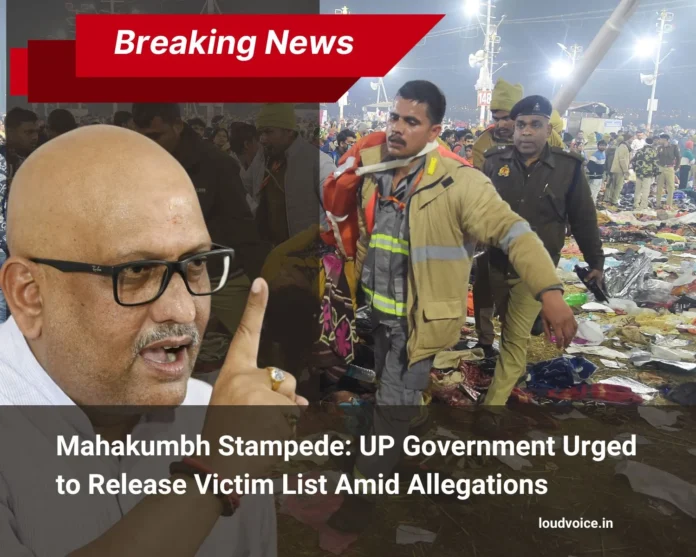Mahakumbh Stampede: Congress Demands Transparency Over Victim List
The Uttar Pradesh Congress Committee (UPCC) has raised serious concerns regarding the Mahakumbh stampede that occurred on Mauni Amavasya at Prayagraj Mahakumbh 2025. Accusations of an alleged cover-up and discrepancies in compensation practices have led to mounting pressure on the state government to disclose the official list of casualties. Critics argue that failure to provide an accurate record not only fuels misinformation but also prevents families from getting proper closure.
Accusations Against the UP Government
UPCC President Ajay Rai has alleged that the state government is withholding crucial details about the actual death toll from the tragic incident. According to him, the administration’s reluctance to release the complete list of victims raises questions about transparency. Many opposition leaders have also joined in demanding a formal response, emphasizing that withholding such information adds to public distress.
Rai further claimed that cash compensation is being provided to victims’ families without the issuance of official death certificates, indicating an attempt to suppress the real numbers. This has raised concerns over legal and financial implications, as families without proper documentation may struggle to claim additional support or benefits in the future.
Case of a Victim from Singhbhum, Jharkhand
Highlighting one such case, Rai mentioned a Singhbhum district resident who reportedly lost his life in the stampede. Despite the state police reaching out to the family with a ₹5 lakh cash compensation, no official death certificate has been issued. The victim’s son refused the compensation, questioning why the amount was only ₹5 lakh when an official announcement had previously set the compensation at ₹25 lakh.
In response, government officials have stated that efforts are being made to verify each claim, but critics argue that the lack of documentation and inconsistent compensation amounts only add to the controversy.
Similar Cases in West Bengal
Rai also pointed out similar instances involving two victims from West Bengal, where families were compensated monetarily while officials from the state denied knowledge of these cases. These discrepancies further deepen concerns regarding the government’s accountability in handling the crisis. The issue extends beyond individual cases, raising broader questions about record-keeping, inter-state coordination, and fair compensation practices.
The Disputed Death Toll
According to Rai, the official toll reported by the state government stands at 30 deaths. However, he insists that the actual number is much higher. Witnesses and local reports suggest that the stampede was far more severe, with multiple unverified claims surfacing from affected regions. The failure to publish a comprehensive victim list has only fueled suspicions of an underreported toll, with some families fearing that their loved ones are missing but unaccounted for.
The situation has led to calls from multiple quarters, including human rights organizations, urging the administration to conduct an independent investigation. Legal experts have also warned that non-disclosure of victim details could lead to potential lawsuits against the state government for negligence and lack of due process.
Growing Calls for Transparency

The Congress leader has demanded immediate disclosure of the full list of deceased individuals, urging the state administration to uphold transparency and accountability. Without the publication of official names, speculation and distrust among the affected families continue to rise.
Additionally, some activists and opposition leaders have called for a judicial inquiry into the matter, arguing that an independent probe is necessary to uncover the true scale of the disaster and to ensure that all victims’ families receive their rightful compensation.
Potential Political Ramifications
The handling of this crisis could have significant political implications as well. With the state elections approaching, opposition parties are using this issue to question the credibility of the ruling government. Some analysts believe that the controversy might influence voter sentiment, particularly in regions directly affected by the tragedy.
Public sentiment on social media has also played a role in amplifying concerns, with hashtags demanding justice for the victims gaining traction. News outlets and independent journalists continue to investigate, adding to the pressure on the administration to release official data and address the growing concerns.
Conclusion
As calls for justice and clarity grow louder in Indian Politics, the UP government faces increasing scrutiny over its handling of the Mahakumbh stampede tragedy. The demand for transparency remains at the forefront, as families seek the truth about their loved ones. With mounting pressure from political opponents, activists, and legal experts, the state administration may have no choice but to take decisive action to address the grievances.
The coming days will determine whether the government responds with transparency and accountability or if the issue escalates into a larger political and social controversy. Given the scale of the Mahakumbh event, this incident may also lead to stricter safety measures and reforms to prevent such tragedies in future religious gatherings.


